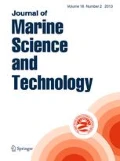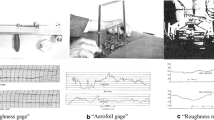Abstract
Ship hull paint roughness considerably affects ship’s resistance. During the ship design stage, the added resistance coefficient, ΔCF, is used as the parameter of added resistance due to roughness. ΔCF is commonly estimated by the ITTC1978 formula using Ks as the roughness parameter. Ks is measured as the average hull roughness (AHR). AHR is composed of the average of Pt50 values (difference between the maximum peak height and the maximum valley depth in the evaluation length of 50 mm) collected from multiple locations on the ship’s hull. However, it has been indicated that not only the roughness height parameter but also the wavelength parameter can affect frictional resistance. In this study, we try to develop a new method for estimating the added frictional resistance using the rotating cylinder test. The relation between the friction increase rate (FIR) (%) and the roughness Reynolds number (k+) is investigated. FIR (%) is dependent not only on the height parameter but also on the wavelength parameter. The projected area of the “cones” above the non-effective thickness, δs, to stream direction per unit area, Aall, which is called the cone projected area (CPA), is calculated using the roughness parameter Rc (i.e., the average height of roughness components) and the wavelength parameter RSm (i.e., the average length of roughness components). The strong positive correlation between the FIR (%) and CPA is confirmed. Using this relationship, the FIR (%) of the roughness cylinder can be easily estimated from Rc, RSm, and δs.









Similar content being viewed by others
Abbreviations
- Re:
-
Reynolds number (–) \({\text{Re}} = \frac{\text{VL}}{\nu }\)
- L:
-
Length scale
- Re_C :
-
Reynolds number of cylinder test (length scale as circumferential length) (–) \({\text{Re}}_{{\_{\text{C}}}} = \frac{{V_{0} c}}{\nu }\)
- C :
-
Circumference of the outer cylinder of cylinder test (m)
- Re_G :
-
Reynolds number (length scale as gap between the inner and outer cylinder) (–) \({\text{Re}}_{{\_{\text{G}}}} = \frac{{V_{0} G}}{\nu }\)
- G :
-
Gap between the inner and the outer cylinder (m)
- V o :
-
Circumferential velocity of outer cylinder (m/s)
- ν :
-
Kinematic viscosity coefficient (pa s)
- C F :
-
Friction resistance coefficient (–)
- C f :
-
Local friction stress coefficient (–)
- ΔC F :
-
Added resistance due to roughness (–)
- τ w :
-
Wall shear stress on inner cylinder (N/m2)
- τ w0 :
-
Wall shear stress on smooth cylinder (N/m2)
- τ wr :
-
Measured wall shear stress on rough cylinder (N/m2)
- ρ :
-
Density (kg/m3)
- u τ :
-
Friction velocity (m/s)
- y + :
-
Non-dimensional distance from wall (–)
- k + :
-
Roughness Reynolds number (–)
- δ s :
-
Non-effective thickness (μm)
- n :
-
Revolution per minute of outer cylinder (rpm)
- H :
-
Height of the inner cylinder (m)
- D :
-
Diameter of the inner cylinder (m)
- r :
-
Radius of the inner cylinder (m)
- S :
-
Sidewall area of the inner cylinder (m2)
- T :
-
Torque acting on the inner cylinder (N m)
- Ks :
-
Roughness height (AHR) (μm)
- Rz :
-
Maximum height of roughness profile (μm)
- Rc :
-
Average height of element of roughness profile (μm)
- RSm :
-
Average length of element of roughness profile (μm)
- RKu :
-
Kurtosis of roughness profile (–)
- FIR (%):
-
Friction increase ratio (%)
- CPA:
-
Cone projected area Aall (m2/m2)
References
MEPC (2011) Amendments to the annex of the protocol of 1997 to amend the international convention for the prevention of pollution from ships, 1973, as modified by the protocol of 1978 relating thereto (Inclusion of regulations on energy efficiency for ships in MARPOL Annex VI) MEPC 62/34/Add.1 Annex 19
MEPC (2012) Guide lines on survey and certification of the energy efficiency design index (EEDI). MEPC 63/23/Add.1 Annex 10
Molland AF, Turnock SR, Hudson DA, Utama IKAP (2014) Reducing ship emissions: a review of potential practical improvements in the propulsive efficiency of future ships. Trans RINA Part A Int J Marit Eng 156:175–188
Candries M, Atlar M (2003) On the drag and roughness characteristics of antifoulings. Trans R Inst Naval Archit 145:107–132
Nikuradse J (1933) Laws of flow in rough pipes. Forschungsheft 361
Denny ME (1951) BSRA resistance experiments on the ‘Lucy Ashton’: part 1. Full scale measurements. Trans Inst Naval Archit 93:40–57
ITTC (1978) Performance, propulsion 1978 ITTC performance prediction method. ITTC-recommended procedures. 7.5-02-3-01.4
Bowden BS, Davison NJ (1974) Resistance increments due to hull roughness associated with form factor extrapolation methods. National Maritime Institute Ship Technical Memo 380
Townsin RL, Byrne D, Svensen TE, Milne A (1981) Estimating the technical and economic penalties of hull and propeller roughness. Trans SNAME 89:295–318
Sasajima H, Yoshida E (1955) Frictional resistance of wavy roughened surface. Int Shipbuild Prog 2:13
Sasajima H, Terao T, Yoko K, Nakato M (1965) Experimental investigation into roughness of hull surface and increase of skin frictional resistance. J Jpn Soc Naval Archit Ocean Eng 117:58–71
Katsui T, Tanaka H (2018) The evaluation method of the hydrodynamic frictional resistance for the painted rough surface. In: Proceedings of the ASME 2018 37th international conference on ocean, offshore and arctic engineering
Mieno H, Katsui T (2019) Development of a portable 3D hull roughness analyzer. J Mar Sci Technol. https://doi.org/10.1007/s00773-019-00656-x
ISO (1997) Geometrical product specifications (GPS)-surface texture: profile method: metrological characteristics of phase correct filters. ISO 11562
WIPO (2016) Method for predicting frictional resistance of rough surface, and surface performance evaluation device WO/2016/125695
Acknowledgements
The research could not have been accomplished without great support and corporation of Professor Yasuo Kawaguchi of Tokyo university of Science, Professor Kaoru Iwamoto of Tokyo University of Agriculture and Technology, and Mr. Hideki Kawashima and Mr. Hiromoto Ando of National Maritime Research Institute. The research was also carried out for the project “Next generation environmental related technology development support program” of Japanese Ministry of Land, Infrastructure, Transport and Tourism, and as a joint research with ClassNK, both entitled “Method to estimate the changing ratio of in situ frictional resistance using the data of reduced surface roughness and roughness parameters of hull coating”. The authors would like to thank MARUZEN-YUSHODO Co., Ltd. for the English language editing (https://kw.maruzen.co.jp/kousei-honyaku/).
Author information
Authors and Affiliations
Corresponding author
Additional information
Publisher's Note
Springer Nature remains neutral with regard to jurisdictional claims in published maps and institutional affiliations.
About this article
Cite this article
Mieno, H., Katsui, T. Experimental investigation of added frictional resistance by paint rough surface using a rotating cylinder. J Mar Sci Technol 26, 1–15 (2021). https://doi.org/10.1007/s00773-020-00717-6
Received:
Accepted:
Published:
Issue Date:
DOI: https://doi.org/10.1007/s00773-020-00717-6



